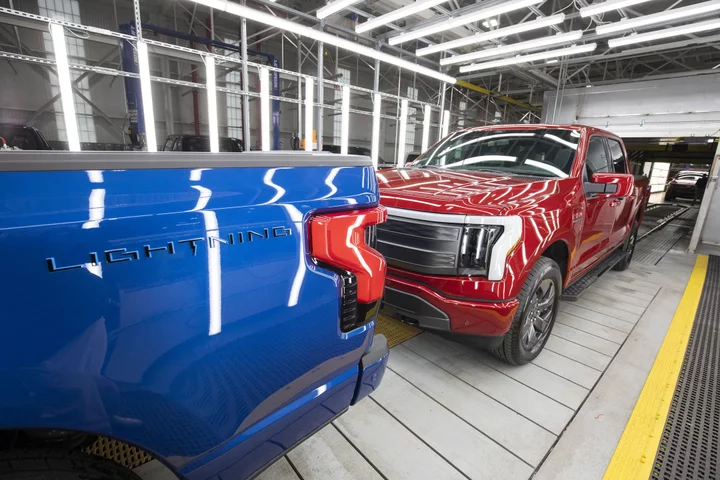Tesla Inc.’s script for popularizing electric vehicles — ramp up production, leverage economies of scale to lower costs and make automobiles affordable enough for a mass market — reads a lot like the one Ford Motor Co. first drew up over a century ago.
Following this game plan has paid dividends lately for Tesla. The stock has more than doubled this year, even as the carmaker has slashed prices. For Ford, taking a page out of this playbook just wiped away about $3.6 billion in market value in one day.
The maker of the best-selling F-Series announced it’s going to triple the production rate for its first electric pickup, the F-150 Lightning, which it initially planned to sell for just shy of $40,000. Like Tesla, Ford jacked up prices during a prolonged period of parts shortages and battery raw-material inflation. Now that chips are more plentiful and the cost of battery inputs including lithium and nickel have eased, Ford is lopping thousands of dollars off what it’s charging customers.
“Everyone loved it when Tesla did it,” said David Whiston, an auto analyst at Morningstar. “As long as they’re truly making improvements in production costs and input costs, then giving some of that back to the consumer makes sense.”
Investors didn’t see it that way, sending Ford shares down 5.9%, their biggest drop in five months.
Ford’s markdowns of as much as 17% for the F-150 Lightning Pro, its cheapest model, may have been jarring to those who heard Chief Executive Officer Jim Farley recently suggest that Ford would be able to stay above the fray of competition. In May, he said the company would avoid EV segments that were becoming “ commoditized” and focus on those with “serious pricing power.”
While an almost $10,000 discount on the cheapest F-150 Lightning would seem to conflict with those statements, Ford is still charging roughly $10,000 more than what it initially planned for the base model two years ago. The battery-powered pickup will still sell at a premium to its gas-powered equivalent, which starts at $33,695.
The all-important question for Ford and its peers General Motors Co. and Stellantis NV will be whether they can maintain their dominance of the full-size truck segment in the electric age. Big pickups have been Detroit’s last bastion in the combustion era, with the three continuing to dominate in the face of attempted incursions by Japanese brands.
Ford rushed to establish a beachhead in electric pickups by quickly converting a gas-fueled F-150 to battery power, getting a jump on Rivian Automotive Inc.’s R1T and Tesla’s Cybertruck. The F-150 Lightning price cuts came on the heels of Tesla announcing it had started production of its model roughly two years behind schedule, while Rivian has been ramping up output.
GM recently started making electric iterations of its Chevrolet Silverado pickup, and Stellantis will start assembling the battery-powered Ram 1500 Revolution next year.
Ford is counting on demand for combustion F-Series trucks — the top-selling vehicle line in the US since the Reagan administration — carrying over to the electric versions. In addition to targeting a 150,000 annual run rate of F-150 Lightning output after its Michigan factory reopens next month following a few weeks of downtime, a second-generation electric pickup will go into production starting in 2025. The new factory for that model, sprouting up in Tennessee, will have the capacity to make half a million vehicles a year.
That’s what may have been most unsettling of all about Ford’s announcement for investors — that the company would drop prices this much and this early in its transition to electric trucks.
“Investors fear this fits recent noted theme of higher US EV inventories,” Chris McNally, an Evercore ISI analyst with the equivalent of a hold rating on Ford shares, said in a report Tuesday. “Time will tell if the Ford price cut was demand or supply,” he wrote, adding that it’s likely a bit of both.

